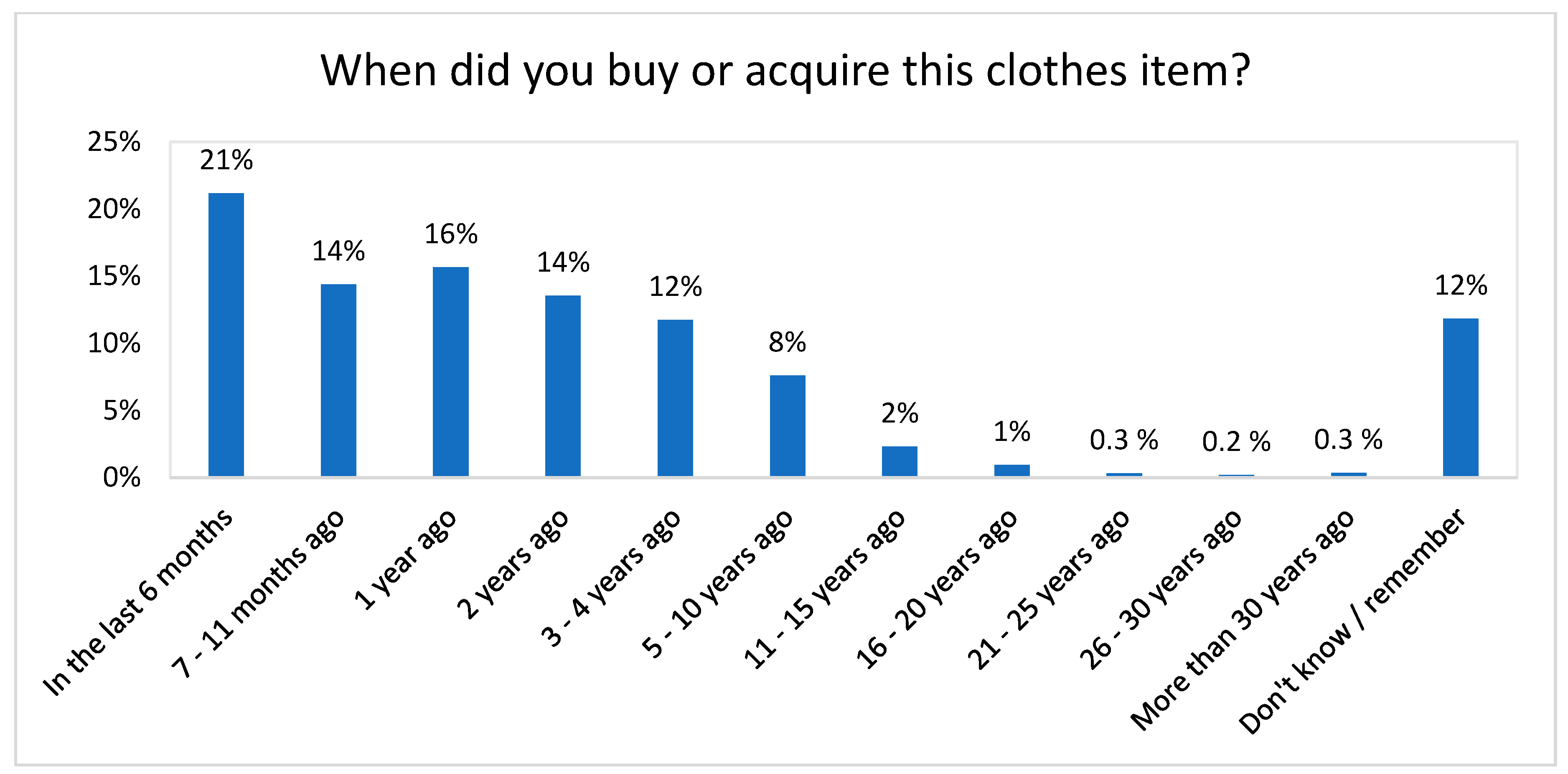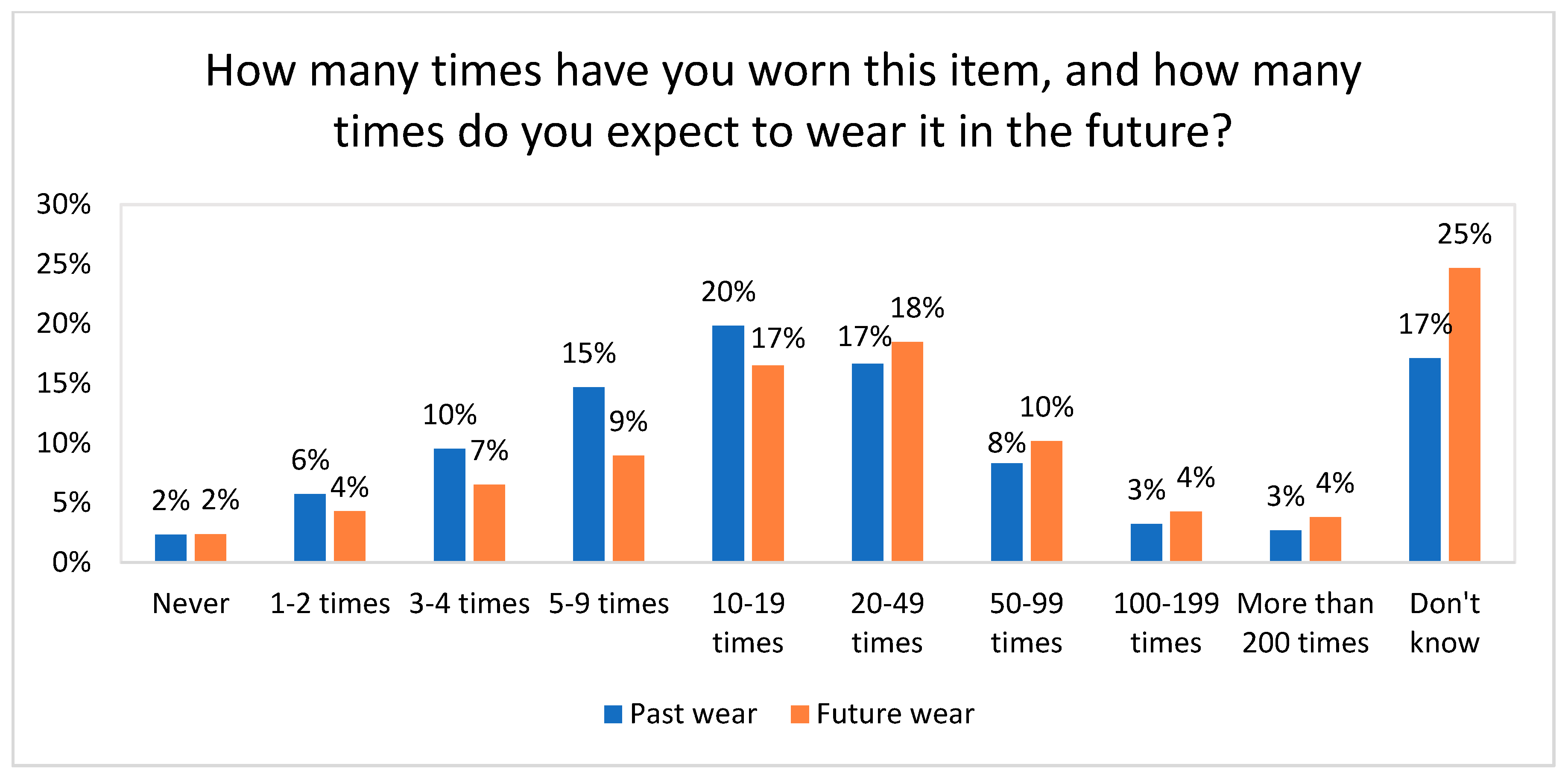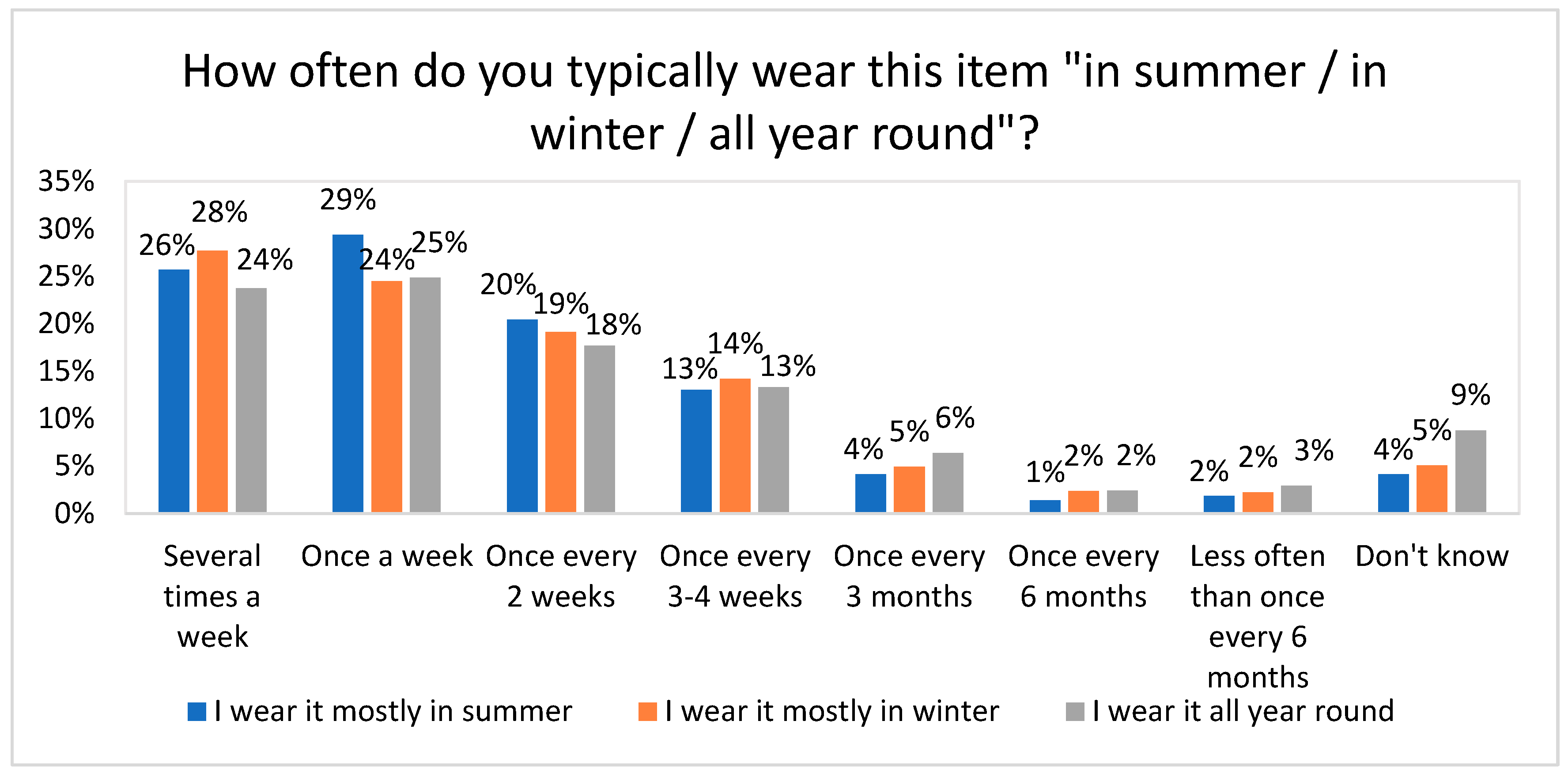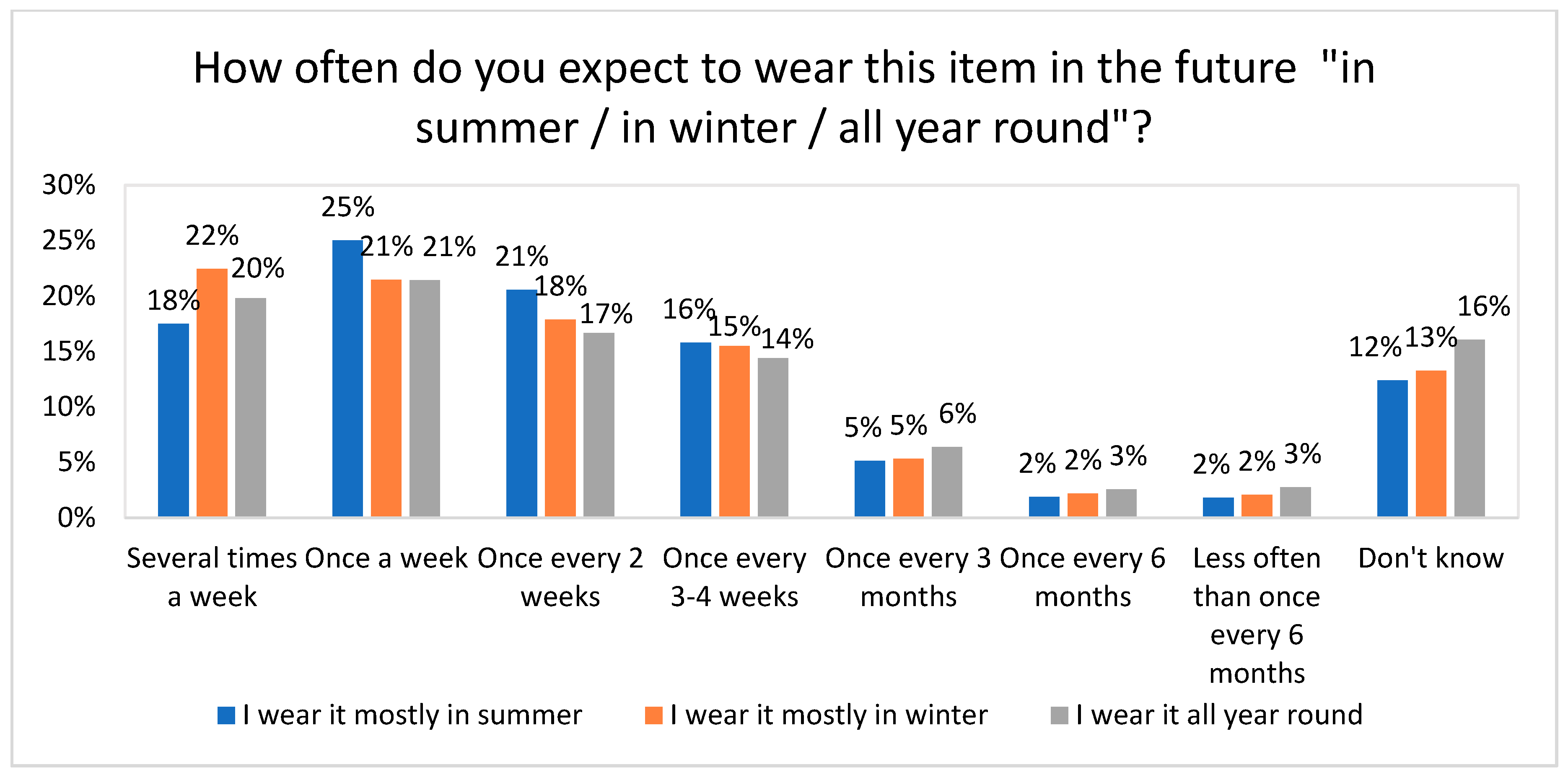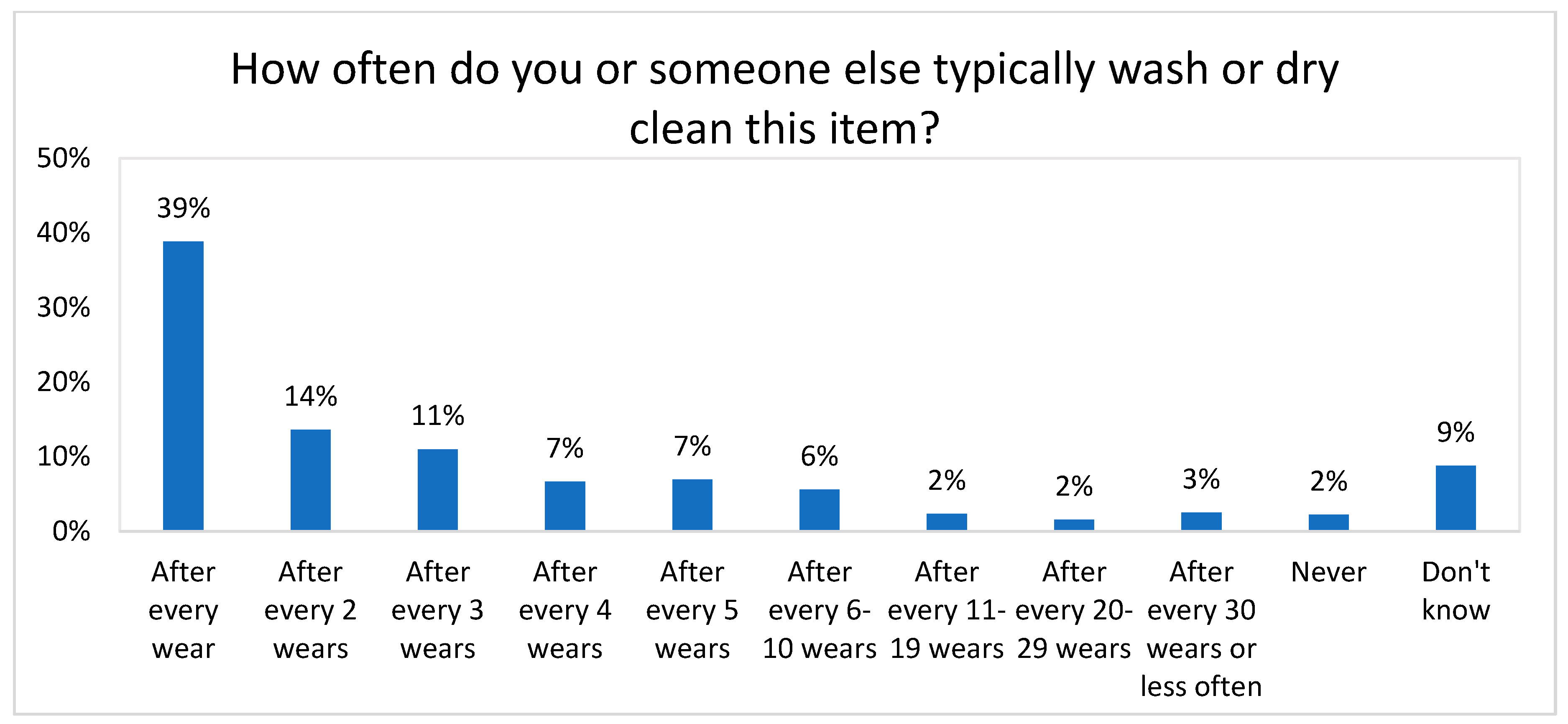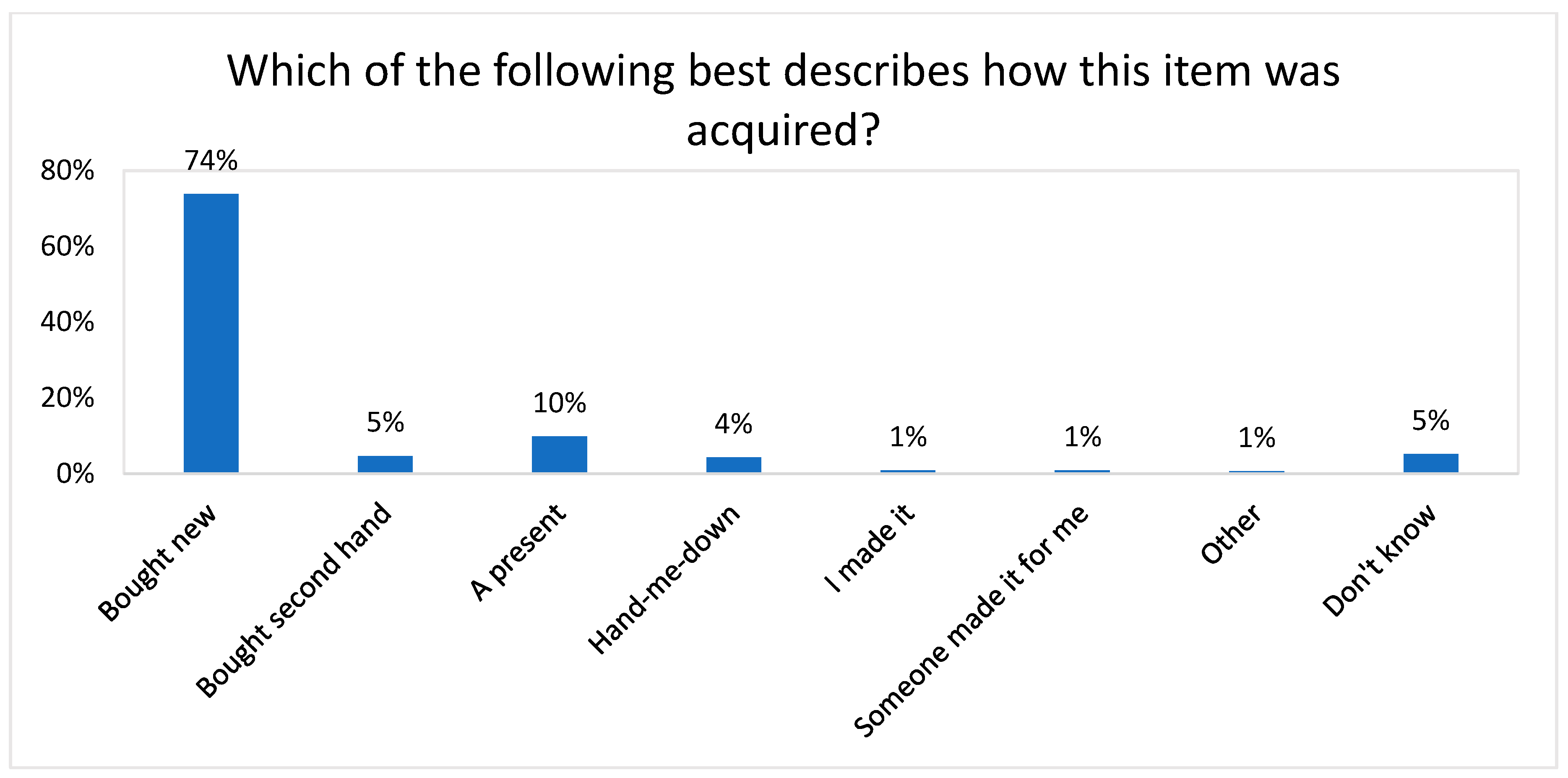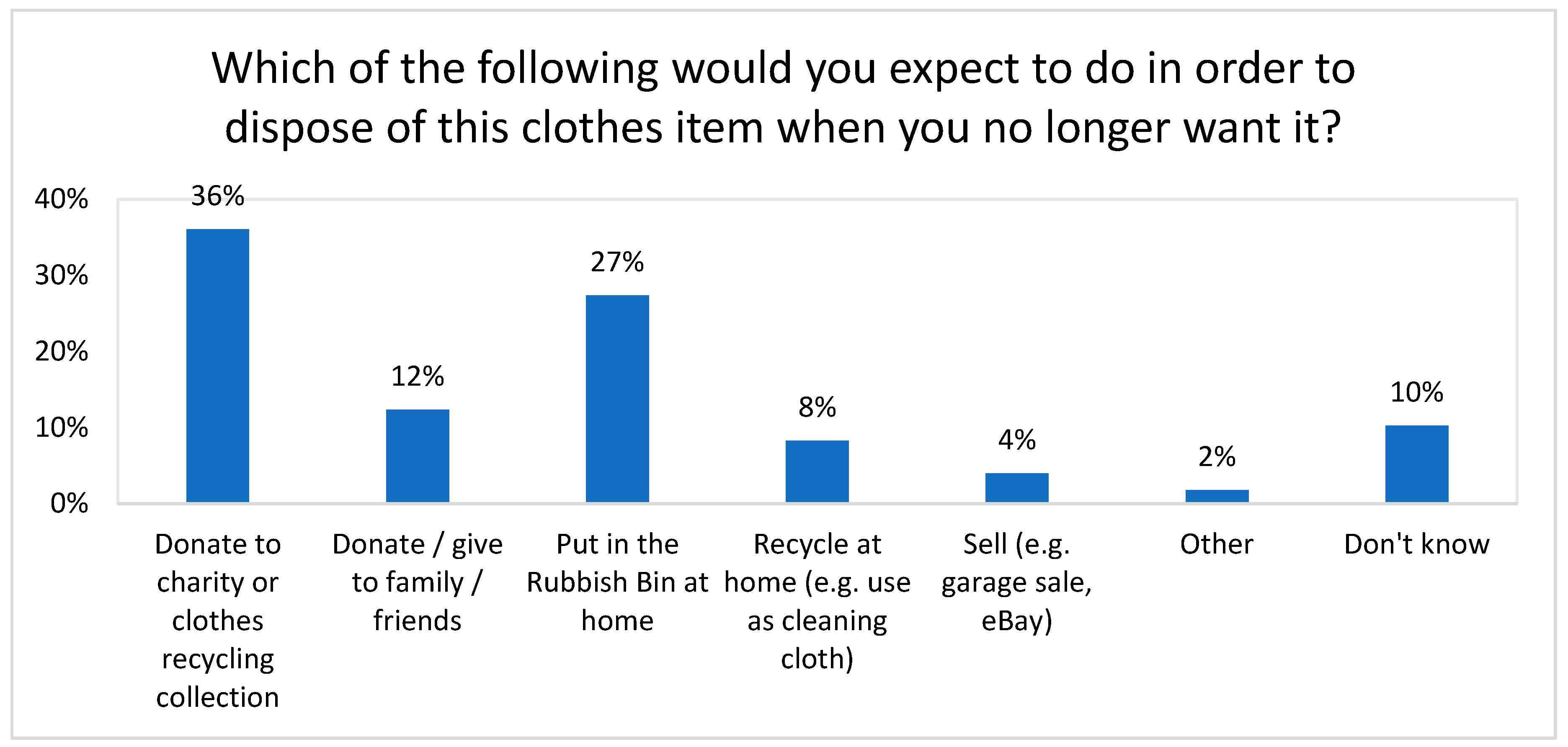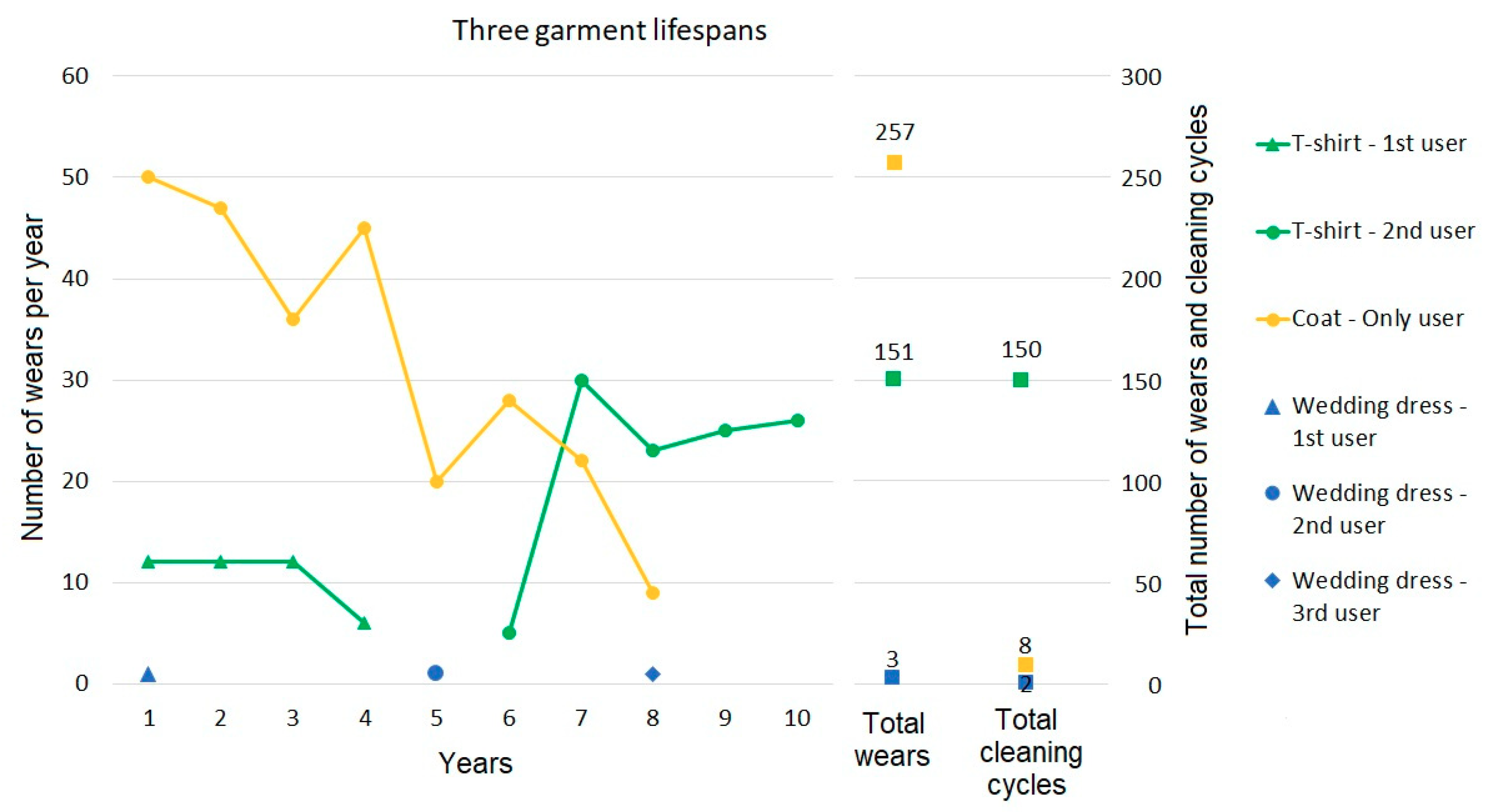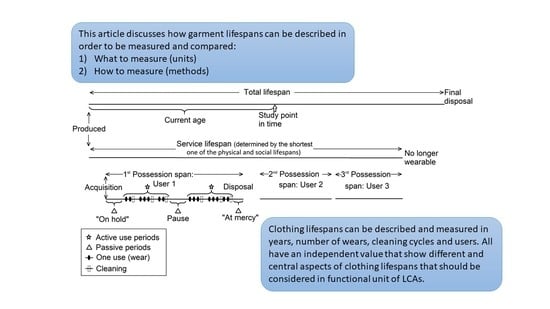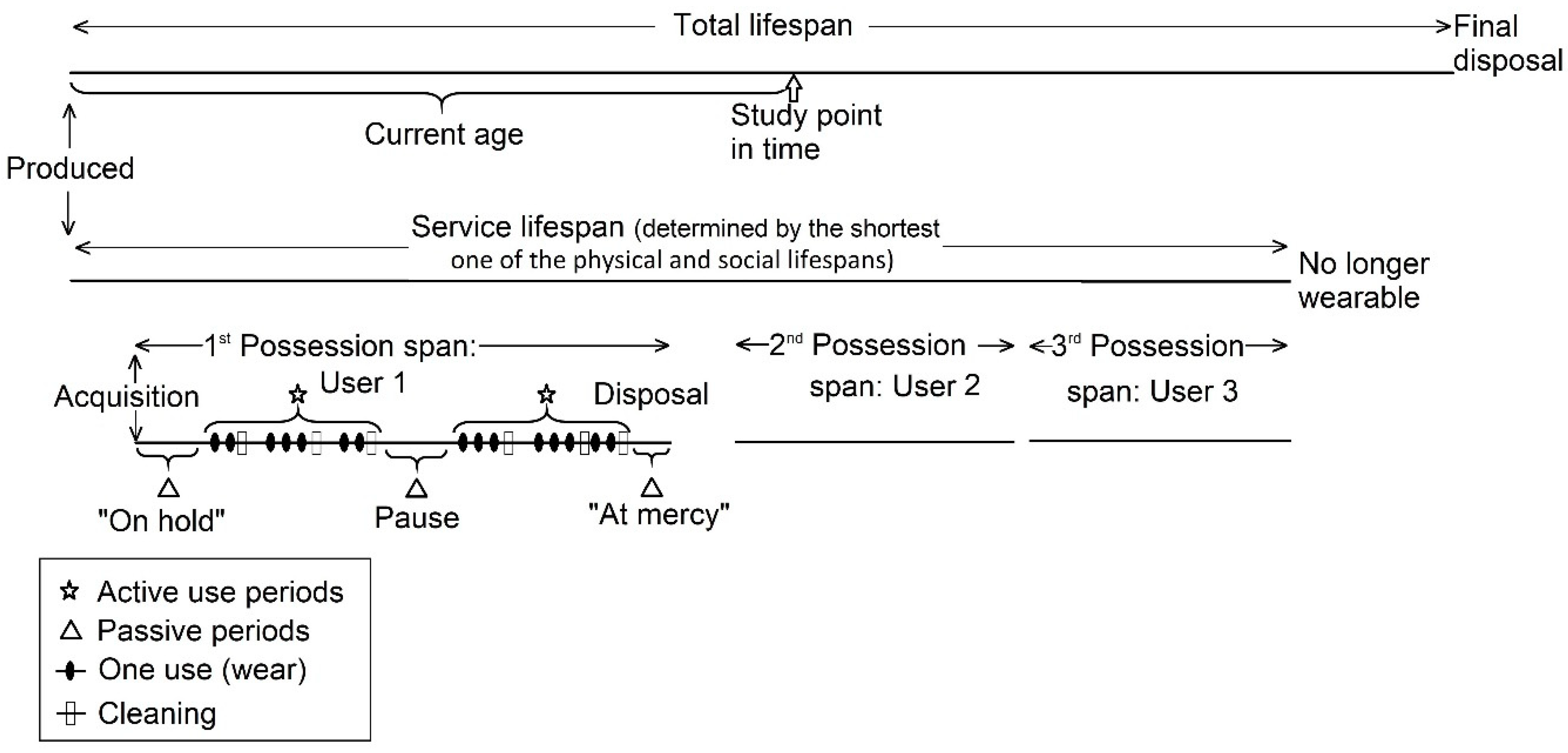1. Introduction
Extending the use of products, often referred to as increasing product lifespans, is one of the most effective environmental strategies, as it has great potential to prevent waste and reduce production, consumption (as in, acquisition and disposal), and transport. This has been conceptually known, documented, and recognised for a long time—for example, in the waste hierarchy where prevention is the top priority [
1]. Research has shown that improvements in the textile value chain are important and improve the efficiency of the production system, but at the same time are difficult, take time [
2,
3,
4], and are often counteracted by increases in textile volumes [
5,
6], which makes extended use even more important. Extending the lifespans for 10% of t-shirts in the market would reduce circa 100,000 tonnes of CO
2 eq and 2000 tonnes of waste per annum in the UK alone [
7], provided the lifespan extension substitutes new purchases.
The interest in research on product lifespans is increasing [
8], and many designers work with developing longer-lasting clothes [
9,
10]. However, there is still only limited research that has focused specifically on clothing lifespans and which factors affect this [
11,
12].
Taghikhah et al. [
13] state that it is not possible to even talk about sustainability without extending the definition of the supply chains to also account for consumers’ behaviour and their influence on the overall system performance. Better knowledge about the use phase of clothing is needed in the work on environmental accounting and improvement, such as LCAs (life cycle assessments) [
14]. In working with product LCAs, functional units are used as measuring units, and defined by the “‘service delivered’, a quantified performance achieved within a given period of time” [
15]. In clear contrast to this, LCAs in a clothing context often use a number of garments or a certain amount of material as the unit, leaving the use of the products out. Polizzi di Sorrentino et al. [
16] argue that the functional unit should be based on measures of behaviour. Piontek et al. [
17] suggest to use “one year of varied use of clothing” as a functional unit, enabling the comparison between a baseline scenario with part of the wardrobe rented. To develop a good functional unit, better knowledge about the use phase is needed [
14]. There is a lack of knowledge about the relationship between different ways of describing and measuring the use phase [
18]. It is urgent to obtain knowledge about how the service delivered so that the use best can be measured. This also includes greater precision in the use of concepts and terms.
This article discusses how garment lifespans can be described in order to be measured and compared. We divide this into two sub-questions:
As our starting point, we use definitions that were developed by Murakami et al. [
19] but have been further developed for clothing.
Total lifespan: The duration clothing exists in our society in its original form, regardless of whether it still functions. Total lifespan starts when the product is manufactured and ready to wear regardless of whether it is sold, used, etc.
Service lifespan denotes the duration of the period that the garment functions and can be put to use, including the duration of use by initial and subsequent users. Use is not only the hours worn on the body, but the entire period the clothing is worn by a user until the last time it is worn. This definition applies for the garments, not for owners. It starts when the first owner acquires it and ends when the last owner discards it.
Possession span denotes how long one owner possesses the garment in question.
Duration in use denotes how long one owner uses the garment in question. This is defined for an owner, not a garment, and therefore this is different from service lifespan. Duration in use differs from possession span in that it excludes the dead-storage span. It starts when the product is taken into use and ends the last time it is used. The term can also denote the time the product is actually used and exclude periods where the garment is unused, or only include the time the garment is worn on the body. For clothing, the term is difficult to define, and therefore we will return to and operationalise the term.
Product age denotes the time span from the beginning of the life of the product (production) until the time of the study or another point of interest, such as a specific point in the lifespan.
The physical lifespan: The time the garment can be put into use in the technical sense. In other words, how long the garment can be worn before it shows more signs of wear than considered acceptable. This is related to the durability (strength) of the garment and the way it has been cared for, and is sometimes also called the technical lifespan. The degree of wear considered acceptable is subject to both physical considerations (i.e., whether a garment can fulfil its function) and also includes social considerations—for example, a slightly frayed garment may not be acceptable as formal wear, while the same degree of wear and tear on an outdoor workwear garment may be acceptable. Hence, it is difficult to define physical lifespan without definitions influenced by social standards and expectations. The physical lifespan starts when the garment is produced.
Social lifespan denotes the time the garment is deemed socially acceptable. As with physical lifespan, this will also be subject to cultural and individual variations, and will vary based on the type of garment. It is connected to the concept of quality “during use” [
20] in contrast to pre-use quality, which it is possible to measure through industry standards. Anthesis and the Waste and Resources Action Programme (WRAP) [
21] have used the terms physical and emotional durability in describing physical and social lifespans. Socially durable garments are those that can be used over a long period of time and still be appreciated or accepted.
The length of the service lifespan depends on the social and physical lifespans. The shortest of the two will determine the end point.
To answer the research question, we will start by discussing how lifespans can best be described and measured based on previous research. This is followed by a method section where we introduce the international survey data. In the results section, we present examples related to various ways of measuring clothing lifespans. Finally, we conclude by answering the research question and point towards which areas need further research.
2. What to Measure?
Product lifespans can address the age as well as the timespan products are in function [
22]. Lifespan for durable products is usually measured in years, but for many products this is supplemented with other measurement units, such as kilometers for vehicles. The lifespan of lightbulbs and other electrical products are measured in how many hours of use they offer. More emphasis is placed on duration in operation than duration in stand-by [
22].
Describing the length of the use phase is simpler for products such as fridges that are usually in constant active use throughout the use phase, and when no longer functional they are replaced by a new one. In contrast, the clothing use phase includes active and passive periods, and acquirement of new clothing does not necessarily replace an existing product but may expand the wardrobe of the owner [
23]. The concept of duration in use is therefore complicated.
In the following, we will discuss different units used to describe lifespans based on a literature survey on clothing consumption [
24]. In addition to years, the units include the number of wears, the number of users, and cleaning cycles. Each subchapter first gives examples of using such a unit, followed by an assessment of whether such a unit is meaningful for environmental accounting and how it can be used.
2.1. Number of Wears
The number of times a garment is used can be measured by the number of wears either during its possession span with one or all owners, up to a specified product age, its total lifespan, or alternatively during a specific period such as a year.
The number of wears is partly related to the number of clothes a user has access to. In a large wardrobe, it is likely that each garment will be used less frequently, and thus it will last longer [
25]. It also has to do with how much the owner likes the garment. If an owner has four shirts and likes one of them best, it may be used as often as possible, or the opposite—it may only be used on special, prioritised occasions. These examples all point to the relationship between the user and the clothes, and the garment’s place in the user’s wardrobe. However, there is another factor that is important for understanding the garment’s number of wears, occasions—all social practices, both ordinary and special occasions, that require clothing.
The use of textile materials and clothing is influenced by cultural and social practices, traditions, and value systems. Clothes are made, sold, bought, and used with an idea of specific occasions. The occasions also influence the way we categorise clothes as nightwear, gala dresses, and swimwear [
26]. The relation between clothing and occasion is central in etiquette and manners literature [
27]. Occasion is the most important factor to consider when people select clothing [
28], and choices are based on societal conventions [
29].
The frequency of occasions the clothes are suited for affects the lifespans of the clothes through the possibility of use [
10]. For example, swimwear and evening wear are worn infrequently and stored and unworn over varying periods. The fact that they might be worn seldom can result in these garments becoming useless because the user changes size, or the garment can become outdated before it is physically worn out [
10]. Thus, occasion is an objective that clothes are made and chosen for, but at the same time it is a prerequisite that enables them to be used. For example, if a consumer has a gala dress, an invitation to a party is needed in order to use the dress. Consequently, occasion can be both:
This second point of view is somewhat unusual but is of particular interest for a study of lifespans. For example, opportunities to use a warm sweater will be greater in cold than in warm climates. A wedding dress may be worn a maximum number of times for a given user, even though it is only used once. For some clothing, the number of possible wears will be very high and far higher than how many times most garments are used. To wear a garment, a suitable occasion is needed. Therefore, occasions impact the number of wears. More knowledge is needed on the relation between clothes and occasions, and the relationship between occasions and the number of wears.
There is little research on garment lifespans measured as the number of times they are worn, i.e., the number of wears. An example can be found in WRAP’s work; Cooper et al. [
12] estimated some wear frequencies, indicating that jeans are worn 75 times per year, socks and knitwear 50 times, t-shirts 25 times, and shirts 16 times. Further, they calculated the total number of wears based on target lifespan measured in years, so that, for example, jeans should be worn 300 times over four years. Survey material from four countries showed that, on average, consumers estimated that they wore their t-shirts and jeans at least monthly over 3–4 years [
30], which would bring the total number of wears to around 42 times. Previous wardrobe studies have shown that there are great variations in the wearing frequencies and number of wears between the garments in wardrobes. It is common that wardrobes include garments that are not in active use. In Norway, about 20% of garments are either never worn or only worn a couple of times [
31], and in the UK around 30% of clothing in the average wardrobe has not been worn for the last year [
32].
Cooper et al. [
12] made more detailed estimations on active wearing by using the number of hours per wear. For the included garment groups, they estimated each wear to last 12 h. The length varies between product groups. Sportswear is likely to be worn only during the activity (typically an hour), while some comfortable home clothes can be worn both night and day. There are also differences between people with respect to whether they wear the same outfit all day or change clothes between the time spent at home or at work. Depending on the number of changes, this can potentially halve the number of active wearing hours per day worn. No current consumer research has focused on active wearing hours in such detail, as far as we know.
The number of wears is interesting because it indicates whether or not the garment is actually in use. It is also important because the active use generates washing and care, and thus not only makes the garment have a function, but also increases the environmental impacts through the consumption of water, energy, and chemicals. Therefore, the number of wears is crucial when estimating the total environmental impact in an LCA calculation. It can be operationalised by dividing the impacts by the total number of wears in order to report an impact “per wear” or by determining impacts for a year of wear with a standardised number of wears by one or several users.
2.2. Years
Years appear as both the most obvious, and most common, unit of measure for garment lifespan [
18]. Our own age is measured in years, and years are a common unit of measurement for a number of products [
22]. Our previous literature review on clothing lifespans showed that years was the most prevalent way to report lifespan [
18], although the reporting was based on the possession span rather than the total lifespan. Based on the nine reviewed studies, the average possession span across all garment categories was four years, but varied greatly between different types of garments, from 2.6 years for socks to over six years for jackets, skirts, coats, dresses, and suits [
12,
30,
31,
33,
34,
35,
36]. These studies focused on product age up to the point in time when the study was completed, or possession span with one current user, not the total lifespan of clothes if owned by more than one user. Only garments kept for a long time can be worn for a large number of times. If clothes have only few potential use occasions, they must have a long possession span either with one or several users to be able to achieve large number of wears.
The biggest environmental impact of clothing lasting a long time is that it can prevent a new garment from being purchased, and thus also from being produced and sold. Years can therefore be used as an indicator for calculating the clothing replacement frequency and the related environmental impacts occurring from the additional raw material manufacture, shipping, and selling of a replacement garment. This is a particularly relevant factor for garments worn only during some seasons or for some occasions, especially ceremonial clothing. There are disadvantages to measuring lifespan in years. A garment that is not used is likely to be kept longer than a garment that is worn often, because the latter becomes worn out more quickly. It is also possible to assume that garments that are kept but not used have no function. Because of this, alternative units have been preferred in LCA research. However, as our discussion on occasions showed, the various garments do not have equal opportunities to be used, and therefore comparison only on the basis of the number of wears is not indicative of their capacity to deliver the function they were designed for.
One way of measuring in years is to take into account that the use phase consists of many stages where the clothing is either worn, stored, cleaned, or maintained in other ways [
37]. In countries with clear seasonal differences, many clothes will be used only part of the year. Summer clothes and winter clothes are linguistic expressions for this. In the UK, WRAP [
34] has used number of years as a measure in their work with clothing lifespans and use. At the same time, they have separated between active and passive clothing in the wardrobe. “Years—with active and passive periods” is a modification of measurement in the number of years, where some of the benefits that focus on the number of times used are included in a simplified way. This intermediate form may have advantages because it requires less resources and at the same time compensates for some of the weaknesses that measurement by the number of years represents. We have illustrated this and the related lifespan terms in
Figure 1.
Number of years is a convenient measure for calculating other lifespan measures, such as number of wears and cleaning cycles, but in addition the garment age itself has a value. We have not seen this argument being used in previous research. This is likely due to a lack of studies focusing on the relation between clothing and occasion. Clothing needs an opportunity to be worn, and different occasions require different clothes. It is necessary to have clothes also for occasions that occur infrequently. A garment owned for many years but only used a few times needs to be socially durable. To specify, garments that are used often must be strong enough to tolerate their frequent use, but social durability is more important for garments that are used infrequently, because they are limited by the occasions when they are required. We thus see a connection between the occasion and whether the social or physical aspects are more important. For people who live in a cold country like Norway, opportunities to wear summer clothes will be limited to a few months, just as those who live in warm countries will only experience a few cold days. Nevertheless, we will need clothing also for these days. Individuals who rarely swim will use their bathing suits perhaps less than 20 times in 10 years. If the suit, for physical or social reasons, must be replaced after 2 years, these 20 times will require 5 different bathing suits, each used only 4 times. Due to the importance of clothing replacement rate, the number of years the particular bathing suit will be functional both socially and physically will thus be as important for measuring the environmental impact as the number of times the bathing suit was used. We all need clothes for several occasions, including those that happen infrequently, whether it be sports, parties, or a funeral. Therefore, lifespan measured in years is an important part of the functional unit of clothes.
2.3. Number of Users
The service lifespan and the total lifespan can be either with only one user or consist of many users that either alternate in wearing the garment, such as sisters sharing a dress [
6,
38], or the same garment changing user and being worn by different people consecutively. Previous research on the sharing of clothing has mainly discussed it as a method of clothing acquisition or disposal, where a longer lifespan through an increased number of users through second-hand clothing markets is considered beneficial [
39,
40]. This is despite the fact that other forms of sharing are more common and provide slightly greater environmental impact savings. A change of owner enables increasing the lifespan and use of a number of clothes that are no longer used by the current owner [
41]. Second-hand garments can have a smaller environmental impact because they can replace the acquisition of a new item, while also increasing the lifespan of the existing garment. At the same time, a change of user has a negative impact on the environment when compared with products used as many times but by one user only, due to the need for additional transport between different users, sorting, and some extra laundering [
39,
41,
42,
43]. With the rise in interest in a sharing economy, many new solutions have been developed for rental, leasing, and other forms of commercial sharing [
44,
45]. These are given a lot of focus in environmental debates, and it is therefore also reasonable that investigating the lifespan of products with multiple users will be important in the future.
2.4. Number of Cleaning Cycles
The wear and tear of clothing occurs when it is worn, but also when it is cleaned [
46]. There is also a connection between clothes being worn and clothes being cleaned. Lifespan can therefore be studied as in how many cleaning cycles (either laundering or dry-cleaning) the clothing tolerates in technical tests, or how many cleaning cycles they undergo during the use phase through consumer studies. The number of cleaning cycles is thus connected to the physical lifespan, but also to consumer laundry habits such as cleaning frequency [
47,
48,
49].
Within textile testing, the number of cleaning cycles the textile withstands is a common measure. This is regularly used to examine whether specific properties, such as waterproofing or flame resistance, still function after a specified number of laundering cycles. Then, the number of cleaning cycles indicates the thresholds for the minimum lifespan of protective clothing. This unit was also applied in the pilot European Commission Product Environmental Footprint Category Rules for t-shirts, where the functional unit is defined as “To wear a clean t-shirt until it becomes dirty 52 times” [
50].
The number of cleaning cycles is important because it provides information about the strength and potential lifespan of clothes, but also because cleaning process itself is an important parameter with an environmental impact. It will thus be useful both in itself and in combination with other ways of describing lifespan.
3. How to Measure
We initially split our research question into two parts, and we will now move on to look at methods for measuring the different units describing lifespans. We assume that the different units have an independent value, as discussion has shown. These units will form the basis for the analysis of how to measure the lifespan of clothing—in other words, how they can be operationalised. We start with a discussion of methods that may be suitable for obtaining data for such operationalisation.
Survey is a widely used research method in social sciences [
51]. According to Polizzi di Sorrentino [
16], it is an important method in the context of an LCA, because it can be used on a large enough scale to be representative of a population of interest. Surveys can be conducted by telephone, online, and on paper, and with closed answer alternatives or with opportunities for open answers. The advantages of surveys are that they are relatively inexpensive, can reflect large and representative populations, can be quantitatively analysed, and can be repeated over time and space to determine trends in behaviour. For a complex question, such as the lifespan of clothes, there will be several challenges with survey material. A major problem is that informants do not necessarily know what the researcher needs to know, such as the average age of the clothes in the wardrobe. Another issue is that the way questions are formulated may be irrelevant to the informant. For example, the questions can be asked as if the informant was the only one using the garments, while in practice they are shared with others. The received material is not better than the researcher is able to ask and the informants are able to answer.
Qualitative interviews and focus groups are based on conversations between researchers and informants. Interviews can be conducted with various degrees of structured questions and can be recorded as audio, as a combination of audio and video, or by taking notes. The advantage is that the informants can have a greater influence and the researcher can gain access to the used wordings, categories, reasoning, etc., which are details lost in surveys. The material is more suitable for qualitative analysis, as it is more time-consuming to interview a large number of informants. The informant’s limited knowledge of their own clothing consumption on a general level will be a limitation also for this method.
Registrations and diary studies are based on methods where informants are asked to record their own behaviour over time. Some examples are given in the method book for wardrobe studies [
52,
53,
54]. For example, it is possible to record all purchases, disposals, laundering, and wears over time. We have not found any studies computing larger volumes registering clothing consumption for entire wardrobes. Methods of registration and diaries have been applied to topics such as laundering [
49]. A major advantage of this type of method is that it is accurate and not dependent on the informant’s memory of past practices. On the other hand, it is time-consuming both for the informants and the researcher, and if the study’s aim is longitudinal, it will also take a long period of time to conduct. The ideal case for studying clothing lifespans would involve registrations over decades so that the entire lifespans of several garments can be covered. Registrations can be especially effective at communal laundries, where a lot of similar textiles are washed together. For example, we know that laundries within the health service mark some garments and record how many washes they can withstand before being taken out of use due to wear and tear. Professional laundries and rental companies are likely to possess useful information about clothing lifespan registrations that has not been utilised by academic research so far. Such registrations provide reliable information on different materials/suppliers/models, etc. that pay off on an industrial scale (personal communication with the leader of a large laundry facility for a hospital in Oslo), and can provide detailed information about the products and their usage.
Wardrobe study, also called wardrobe audit, is a relatively new method that combines questions for informants with registrations of individual garments. A characteristic of the method is that it asks the same questions about all the garments in the wardrobe, or within a specific group. Wardrobe studies have been developed as a method for gathering knowledge about clothing usage suitable in discussions about the environmental impact, such as lifespans. The wardrobe studies are less dependent on the informant’s knowledge because less generalisations and evaluations are left to them and can be done by the researcher. Wardrobe studies give the researcher access not only to the experiences and opinions of the owners, but also the clothes themselves. They can be recorded and photographed, and information such as fibre content, colour, and brand will thus be more accurate. It is also possible to analyse the garments technically through measurements or objective evaluations to say something about the age, degree of wear, traces of repairs, etc. Wardrobe studies can thus be combined with studies of the garments, which we shall return to. One disadvantage of wardrobe studies is that they are costly, time-consuming, and difficult to complete for entire wardrobes and populations.
Wardrobe surveys are a further development within the survey genre, where wardrobe studies have inspired surveys to state questions about each individual garment and its use. This method can be considered to be a hybrid between the two methods [
35,
55,
56]. It combines several advantages from both methods: from a survey primarily the possibility of a large quantitative material suitable for statistical comparisons, and from the wardrobe study focused on individual garments and their characteristics. It is an expensive method compared to regular surveys as it takes a longer time, but it enables quantitative analysis, as presented here. The material can be studied either by using the respondents or garments as units of analysis.
Automatic data capture: In addition to asking the consumers, the use can be tracked with the aid of new technologies such as radio-frequency identification (RFID) for reading tags attached to clothing. The tags can contain electronically stored information. Employing these technologies will enable researchers to gain accurate information about clothing lifespans, that could also be combined with consumer studies.
Experiments involve the manipulation of one variable in order to assess its impacts on a dependent variable. These kinds of research designs are traditionally used by physical and behavioural researchers but also are possible within social sciences. We have not found experiments that focus on complete clothing lifespans, but there are studies focusing on parts of lifespans such as laundering frequencies [
57,
58,
59,
60,
61] and acquisition, such as willingness to pay for specific properties [
62,
63,
64,
65]. The advantage of experiments is that it is possible to isolate factors and still study products in use. One challenge is to find a good balance between the laboratory’s requirements for controllable and repeatable parameters, with the great diversity of daily life. Experiments are particularly suitable for “translating” between use and standardised measuring units—e.g., wear and tear [
66].
All these methods are usually applied to products that are already in use. When aiming to predict lifespans of new products, they could either be based on studies of similar products that are already on the market or be conducted as user trials and experiments during the design phase. It may not be possible to conduct trials that cover the complete lifecycle of garments due to timelines of production, but it could be possible to focus on aspects such as laundering frequencies or minimum technical lifespan.
4. Materials and Methods
We have chosen to use one of the methods, a wardrobe survey, as a means to see in more detail whether it is suitable for providing knowledge about various aspects of longevity and how the information can be operationalised. Along the way, we will give examples of how the choice of method affects the results. We use a recent wardrobe survey conducted by AC Nielsen. We have contributed in the development of the survey, and will use the same material for analysing empirical findings in other publications [
25,
67,
68,
69,
70]. These articles will include a more thorough presentation of the method as well as statistical analysis of the findings.
The online survey was answered by 1111 respondents that were divided quite equally between five countries from big consumer markets representing different continents (China, Germany, Japan, the UK, and the USA), the sample being 213–230 respondents per country. The sample was pre-stratified to represent the gender and age distribution as well as area of living in the country in question, except for China, where only the 11 largest cities were included and the sample was younger than the country average due to less internet-use among elder citizens. The respondents were working age adults (18–64 years old), and 51.6% were women and 48.4% men. The age distribution was 25% 18–29 years old, 46% 30–49 years old, and 29% 50–64 years old.
Questions about wardrobe content and usage practices were related to specific clothing items and included detailed questions about the possession lifespan, number of wears, occasions, acquisition, and disposal methods, as well as laundering practices. The questions were asked both retrospectively—when did you acquire this item and how many times have you worn it?—as well as related to the future wear: how many times do you expect to wear this item in the future?
The consumer-based methods present some different challenges in terms of measuring clothing lifespans. An obvious weakness of this method is that the informants will answer based on what they believe the use has been and will be, and not necessarily based on the actual use. It is difficult to remember how old all garments are, especially if they are more than a couple of years old but cannot be linked to any specific life events. In wardrobe studies, it would be possible to ask the respondents to create relative timelines by grouping the garments based on their age [
71], but this is more difficult in an online survey study. Regular clothing is not labelled with production year, serial number, or other data that consumers could use for identifying their age, as opposed to many other durable goods, such as cars and household appliances.
Some of the garments are brand new, while others are close to disposal stage. Therefore, they are not at a common stage of their “life” for their owners. We have assumed that the current age is average, and multiplied it by two to get an estimation of the average total possession span in years. This way of estimating the possession span by doubling the current lifespan will not be correct for the individual garments, but it will be a close estimate for the average of the total number of garments, as long as the respondents do not change their habits in the proximate years and keep all the clothing shorter or longer than earlier. Garments reported as purchased “in the last 6 months” were coded as “3 months”, while garments purchased “more than 30 years ago” were coded as “35 years”, thus giving the highest possible total possession span of 70 years and the lowest span of six months.
To prevent respondent fatigue, the number of clothing categories assessed in detail were limited to selected focus categories. The total number of registered garments was 53 461, out of which 19% were socks/stockings; 30% were next-to-skin garments such as t-shirts, polo shirts, sportswear, and thermal underwear; 9% were jumpers, sweaters, or cardigans; 11% were trousers/pants; 9% were skirts/dresses; 4% were scarves, shawls, pashminas, or stoles; and 18% were overcoats, jackets, blazers, or suits. Item-specific questions were also limited to a maximum of 10 items per clothing category. This means that if the respondent had 15 suits, he registered details for 10 of them, but if he had six, he had to register all of them.
In the following section, we will use this wardrobe survey to show how it can be applied to studies of different garment lifespan measuring units and used to discuss and evaluate the methods based on garment properties. The analysis was conducted with SPSS statistical software and reported here as descriptive figures with some basic statistical analysis such as standard deviation (SD).
5. Results
We will now look at how garment use measured in different lifespan units can be operationalised for an environmental impact assessment.
5.1. Years
We asked the respondents when they bought or acquired the specific clothing items (
Figure 2). The current average age of the garments is 2.6 years (SD 4.1, N = 46,857), indicating that the total possession span with the current user is 5.2 years. This is slightly higher than the average of four years that a previous literature review indicated [
18]. The respondents were not able to give any age estimate for 12% of the garments.
Our survey did not include a question about how old the respondents thought the garments were in total, when including the potential previous use periods of previous owners. This would likely have been very difficult to estimate and answer. Years with active and passive periods will be used in the discussion of the number of wears.
5.2. Number of Wears
Questions related to the number of wears can be stated in many ways. We will demonstrate two of them based on the wardrobe survey. In the first example, we have asked the respondents to estimate the number of past and future wears. In the second example, we have analysed the respondents’ answers to questions about the number of wears by combining how frequently the garment has been worn and is planned to be worn in the future, whether it is worn all year around, and how long the current user has owned it.
Based on consumers’ estimates: We use two survey questions that were stated for each studied garment: “How many times have you worn this item?” and “How many times do you expect to wear this item in the future?” (
Figure 3). The results show that respondents could not estimate the number of times the garments were worn for 17% of the garments, and the future wear was unknown for every fourth garment (25%). The answers were coded to the average of each category in order to calculate the mean wear values. The highest possible answering category for these two questions was “more than 200 times”, which was coded to 250 wears. If excluding the unknown answers, the respondents estimated that they had worn the garments 33.5 times (SD 51.1, N = 44,136) and were likely to use them 44.0 times more (SD 59.8, N = 39,588), which indicates 10.5 wears more in the future than they were worn in the past, on average. Further, the current and planned number of wears were combined for each garment, which enables values to vary between 0 and 500 wears for this variable. This estimation gave an average number of 76 wears (SD 97.4, N = 38,948). This estimation is a bit lower than the sum of past and future wears, because it only includes those garments where the owner has answered both use estimations, and thus the total number of garments is lower.
Based on reported wearing frequency: We asked if the clothes were worn all year around, or for part of the year mainly during summer or winter, and then how often the garment was worn during that active use period—for example, every second week. It was thus possible to analyse the clothes’ potentially active and passive periods. The respondents could also answer that the garment was not currently in active use. For this estimation, winter and summer were assumed to be four months long. The answering categories vary from several times a week to less often than once every 6 months. Most of the garments were worn all year around (42%), followed by those worn mostly in the winter (29%). A total of 21% were mostly worn during summer, and 7% were not in active use. Further, the answers related to wearing frequencies given in
Figure 4 and
Figure 5 show that most of the garments were used at least once a week. Additionally, here many more are uncertain about future wearing frequencies. The respondents assume that they have been wearing the garments a bit more frequently in the past than what they expect to do in the future. When “Don’t know” answers are excluded, 55% of the garments have been worn at least once a week, while only 48% are assumed to be continued to be worn as frequently in the future. When combining the past and future wearing frequencies, taking into account whether they are worn only part of the year or all year around, and the age of garments in years, the estimation gives a total number of 105 wears (SD 227.0, N = 36,119 garments).
These two ways of measuring number of wears by the current owner gave two estimated figures, 76 and 105 wears. The two variables were significantly positively correlated (r = 0.367,
p < 0.001); however, there is a significant difference between them (
p < 0.001). The difference between these two ways of measuring number of wears is 29 wears. There are several possible explanations for this difference. The estimation based on wearing frequency includes more uncertain aspects, such as that wearing may not occur at regular intervals in accordance with the given answering categories, or that the summer and winter seasons vary in length and some clothing may be worn during two or three seasons. However, this higher estimate is closer to the average of 115 wears that Cooper et al. [
12] estimated based on five garment types.
This shows that there is an advantage to using method triangulation (several ways of measuring) in order to achieve more accurate estimates and to be able to control the answers against each other. Our example shows that it is possible to use the same analysis in several different ways of asking and calculating within the same method: wardrobe survey. It would be beneficial to add a third way of measuring that could be used for monitoring the answers, such as automatic data capture for a few clothing items for comparison purposes. This is especially valid when estimating the lifespans of older garments, where the uncertainties are higher.
5.3. Number of Cleaning Cycles
We have previously discussed how the number of cleaning cycles can be studied based on diary registrations. To do this based on the wardrobe survey, we have combined information from different questions: possession span in years, cleaning frequency, and frequency of use. Cleaning frequencies as in the number of wears between washing or dry-cleaning are given in
Figure 6. This shows that the cleaning frequency of garments varies greatly. Excluding “never” and “don’t know” answers, the average number of wears before cleaning is 4.5 times (SD 8.7, N = 47,354).
The number of cleaning cycles during duration in use is calculated by dividing the total number of wears by the number of days each garment is worn before cleaning. This varies greatly between the different garment types, from the 11 cleaning cycles of coats and scarves to the 73 cleaning cycles of socks during their possession span with the current user.
5.4. Number of Users
When studying clothing lifespans such as total lifespan, service lifespan, and physical/social lifespan, one of the methodological difficulties lies in the fact that garments can have more than one owner or user. The duration of use by one owner is not necessarily equal to the total lifespan of the garment, because clothing is shared [
38,
72,
73]. The wardrobe survey we use is based on the current owner and does not provide information about the clothes’ lifespan related to other users. It does not take into account all the different forms of sharing, except for cases where the owner and user are the same person, and the sharing occurs sequentially through the change of owners.
Methods that are based on the information the consumers offer will, in general, only give information about his or her use period. Concerning past use, we can establish whether the garment has had a previous owner, but little is known about how frequently the previous owner used the garment. The information on potential future use is even more uncertain, as in how long the current user will keep the garment in active use; the way it will be passed on for either reuse or disposal; and, if donated to reuse, whether there will in fact be a next user that will wear it. In general, previous studies that have focused on clothing reuse show that in Western countries, it is more common to give or sell clothing for reuse than to acquire pre-owned clothing [
30,
74]. In addition, there are differences in how common these activities are among consumer groups, garment types, and properties such as fibre content.
In our example, we have asked the respondents how they acquired each of the garments (
Figure 7) and what they plan to do with them when they are no longer wanted (
Figure 8). Similar to the previous questions, the share of “don’t know” answers is higher for the future than for the past use. Most garments have been purchased as new by the respondents themselves, followed by having been received as gifts. A larger share of garments has been bought second-hand (5%) than received as hand-me-downs (4%, indicated as “It was given to me as the other person no longer wanted it”). We assume that gifts are mainly new items, as the hand-me-downs category would include those items that have been used before by the gift giver. In total, 9% of the garments have been preowned, and thus have had at least two owners.
The most common destination for the garments after the end of use is donation to charity or a clothes recycling station (36%), followed by disposal in the rubbish bin (27%). In total, 52% of the garments are planned to be disposed of in a way that they have a potential for a new user either through donation or sale.
When combining the information from these two questions presented in
Figure 7 and
Figure 8, we see that 45% of garments only have one user, and on average the garments have 1.6 users. A future use is very uncertain, as a share of donated clothing does not end up being reused. A recent study of a large international sorting centre showed that they sorted 75% of the donations for textile reuse, the remaining 17% for recycling, and 6% as waste [
75]. We have not seen studies that document that all garments sold for reuse actually get a new user. If we assume that 25% of donated clothing does not get a new user, the total number of users is reduced to 1.5 users. Thus, the survey data revealed information about three users: the current user, the former user, and the potential subsequent user for the garment. The garments may have had other additional users before or after these three users, and our method based on asking the current owner does not give information about this. It is of interest to study further whether the second or even third possession spans are as long as the first one.
6. Discussion: Suitable Units and Methods for Studying Clothing Lifespans
All the various measures of lifespans, as in the number of years (or other units of time), the number of wears, the number of users, and the number of cleaning cycles, have an independent value. They are combined and illustrated in
Figure 9. It shows three garments with varying number of users, wears, cleaning cycles, and years they are in active use. Depending on the situation, it will vary as to which one of the four ways, or a combination of them, will be the most suitable research strategy.
In our example, the global wardrobe survey results indicate that the possession span of garments with the current owner is 5.2 years and are worn about 76–105 times during this period. A total of 9% of garments were pre-owned, and 52% were planned to be delivered for reuse, therefore having approximately 1.5 users. The last aspect is most uncertain, as the survey method is based on information from one user.
The different units provide different insights. Years can be used to describe the total lifespan, indicating the time that a garment remains available for use for occasions that require the garment. The value of long-lasting garments is that they can prevent a new garment from being purchased, and thus also from being produced and sold. It is also well suited for describing possession span, which denotes how long one owner possesses the commodity in question and product age, the time span from the beginning of the life of product to the time of the study, or another point of interest. Service lifespan, the duration of the period that the clothes can be put to use, includes all of the users as well as the time periods needed for distribution between the users. Years are also important for studying other units, as we have shown. It is methodologically easier to ask informants about their current practices and then multiply the results with the number of years.
Years are not well suited for describing how much something is used or can be used. The other measuring units related to wear have a better correlation with use. The use of clothing itself has a time aspect. This is expressed in the definition of duration in use, which denotes how long one owner uses the commodity in question. Duration of use differs from possession span in that this excludes dead-storage span. It is negotiable when clothes are considered “active”. If you bring a rain jacket with you on a mountain hike, you feel safe—even if it did not rain. Clothes in the wardrobe can be said to be active when they are part of the wardrobe we have an active relationship with—even when they are not worn. Passive clothes are thus only those garments that have been put away or stored and not planned to be used again. We therefore suggest that the duration of use is not defined as the hours, days, or times garments are worn on the body but when the clothes are an active part of the wardrobe.
In addition to the length of use measured in time, it is also important to know how often clothes are used. This can be measured in the number of wears. Each wearing can consist of a different number of hours, but still has a common meaning. Different garments will be worn for different time spans per use. We would assume that typical garments for a short period of time per use are bathing suits and other sports and exercise clothes, while socks and underwear are worn for a longer time. If this detailed data of wear is beneficial, the wear results could be normalised for the time span a garment is worn (for example, 1 or 16 h). This aspect will be easy to study empirically, but as far as we know it has not been done previously. After each wear, the garments will be referred to as “used”, and there will be an evaluation of whether they should be cleaned in order to be wearable again. These processes of wearing and cleaning are also the ones that make the number of wash cycles suitable for lifespan studies.
An important area for employing knowledge about product lifespans is LCA. In these assessments, functional units are used as measuring units and defined by the “service delivered’, a quantified performance achieved within a given period of time” [
15]. For clothes, this means they need to have a clearly described function. We have argued that clothing may have a function even when they are not in actual use, particularly for garments required for occasional use, because the owner needs clothes for different occasions, including those that occur infrequently. Clothes that last—that is, that have a long duration in use—remain in the wardrobe because they have a function. Thus, years are not only a unit that can be used to calculate the number of times of use, but a unit that is relevant for the replacement frequency of clothing.
The ideal functional unit should be based on a combination of the number of wears and duration in use by all owners, but we currently lack sufficient knowledge to recommend how to operationalise this. The importance of one aspect versus the other will vary for different garments. The number of wears could be a starting point for daily outfits and other basic clothing that is worn frequently. The fewer potential use occasions, the more important the years and number of users become. In extreme cases, such as a bridal gown or christening dress, only the number of users will be relevant, as it will be the same as the number of wears per user. Other examples of clothing that many consumers will use infrequently include ceremonial clothing; clothing for formal dress-code events (evening gowns, frock coats, tuxedo jackets, etc.); semi-formal wear, such as suits and cocktail dresses; some sports/leisurewear, e.g., skiing clothes, bathing suits, or mountain wear; seasonal clothing (winter and summer-specific garments such as thick wool sweaters, mittens, scarves, or hats); clothing for family celebrations and yearly festivities, such as carnival outfits and Christmas sweaters; and other specific occasions, such as tournaments. Years could therefore be a good starting point for a functional unit for these types of garments. This is important for being able account for the need of more garments to cover all the relevant occasions during specified time periods, thus including the aspect of replacement rate in the equation for functional unit. Where possible, the functional unit should include all the users of the item in question.
7. Conclusions
The article started with the question of how garment lifespans can be described in order to be measured and compared. The question was divided into two questions: what to measure (units) and how to measure (methods). The answer to the first question is that it is not one unit, but several, and that they provide different aspects of the use of clothing, all of which are relevant to environmental impact discussions and environmental accounting and improvements such as LCA.
Clothing lifespans can be measured in years and the number of wears, cleaning cycles, and users.
Functional units in LCA should emphasise both the number of wears for all users as well as the service lifespan in years. Number of wears is the best measure for regular clothing, while number of years is most suited for occasion wear.
The answer to the second question is that it is possible to study garment lifespans through carefully constructed surveys, providing key data relating to actual garment use. A wardrobe survey provides many opportunities to analyse lifespans, but would be significantly strengthened if it was combined with data that are not dependent on the informants’ knowledge and memory, such as automatic data capture. We would therefore like to welcome studies on lifespans based on such approaches.
The main challenge of using this type of survey method is that we receive very little to no information about the garment use by previous and/or future users. Labelling garments with a production date would improve the quality of wardrobe survey as a method and could be an easy way for the industry to make it easier to gather knowledge about the lifespans of clothes.
This article has demonstrated how to gain more comprehensive information about clothes’ lifespans based on a wardrobe survey, where consumers have answered questions about the use and age of specific clothing items. Furthermore, it is also possible to use this material to answer other questions about clothing lifespans, such as which characteristics of the garments, use occasions, or owners affect lifespans the most, and the relation between the consumer survey and other possible ways of estimating or predicting clothing lifespans.
The terms used to describe products’ lifespans are often unclear. We have contributed by defining the most relevant terms that describe the use phase for clothing. The concept of duration in use is still challenging. How active and passive periods are defined can differ. We have argued that use should not only be defined as when the clothes are worn on the body, but that having clothes for different occasions is important also for those occasions that seldom occur. Clothes can also have a function by being simply available. There are different usage frequencies for clothing for special occasions and those that are used more regularly. How could the temporality of the use phase be studied further? A good starting point would be an exploration of the concept of occasion—that is, what makes clothing usable.
The article has contributed with important insights for a way towards a better understanding of functional units in environmental assessments, but work remains on how to operationalise these and whether the various units to describe and measure lifespans actually vary in relevance for different groups of clothing.
More use of each product and fewer products produced are crucial in reducing climate and environmental impacts. This article has contributed to the clarification of important concepts for this work and how they can be operationalised so that the length of the use phase, often called “lifespan”, can be measured. Much of the work done in the textile sector to reduce the environmental footprint does not take the use phase properly into account. Our most important contribution is to make this possible. Further work can use the concepts and methods presented here to compare products, countries, or consumer groups so that work on clothing longevity can be based on a solid, fact-based foundation.
